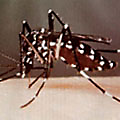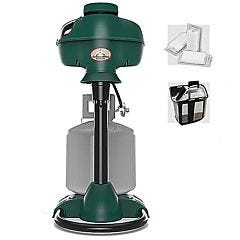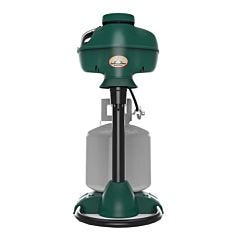Asian Tiger Mosquito

The Asian Tiger mosquito is a vector (carrier) of Dengue Fever, and a potential carrier of Yellow Fever, encephalitis, and heartworm in pets.
After first being found in Houston, TX, this mosquito species has quickly spread to other areas within the US. As a carrier of Dengue Fever, this mosquito species is believed to have been brought into the U.S. via shipments of old tires from Asia. We recommend preventing these pests before they become a problem. Mosquito Magnet® offers a variety of solutions when it comes to dealing with the Asian Tiger Mosquito.
Stop Tiger Mosquitoes Today
Description
The Asian Tiger mosquito species is a vector (carrier) of Dengue Fever, and a potential carrier of Yellow Fever, Encephalitis, and Heartworm in pets. This daytime biter inflicts painful bites on humans which are the preferred “dinner” of the female mosquito. Learn about the symptoms of Dengue Fever, as well as the Dengue Fever mosquito breeding grounds.
Native to the tropics as well as a carrier of Dengue Fever, the mosquito name of the Asian Tiger originates from its striped tiger appearance. Approximately 3/16 inches in length, the Asian Tiger mosquito’s body is black with one white stripe on the body and several white stripes across legs. This "Dengue Fever" mosquito species has antennae that are shorter than its head. Like every other mosquito, it has six legs and only one pair of wings.
Larvae are known as wigglers since they seem to move in that manner. They feed on fungi, bacteria, and other tiny organisms through straw-like filters. These larvae will undergo growth throughout the four instars of this stage.
Pupae are known as tumblers because of the way they seem to “tumble” through the water. Their rounded, comma-like shape makes this mode of movement easy. These pupae do not eat during the 1-2 days in which they will become an adult mosquito.
Breeding Habits
The Female Asian Tiger mosquitoes will lay their eggs in almost any container. "Dengue Fever" mosquito breeding grounds include old tires, bottles, flower pots, aluminum cans, swimming pool covers, plastic cups, tree holes, and many other items that can hold even small amounts of water.
It is this flexibility in breeding habitats or containers that helps to make the Asian Tiger mosquito so prolific. Even without manmade discarded containers, the mosquito would still have plenty of choices for egg-laying. As long as there is a small amount of water, the Asian Tiger mosquito will continue to lay its eggs there. For information on stopping these pests from breeding on your property, check out our guide on How to Prevent Mosquito From Breeding on Your Property.
How Do Mosquito Migration Patterns Affect Us?
The Asian Tiger mosquito can survive in a wide range of climates, making it adaptable to virtually every state in our country. Due to mosquito migration patterns, the Asian Tiger mosquito can be currently found in more than 30 states, with states reporting the mosquito each year. If you live in the United States, most likely the mosquito migration patterns of the Asian Tiger will affect you. This mosquito has become a major pest in many communities, due to its close association with humans.
Not only does the Asian Tiger mosquito feed during dusk and dawn, but all day as well. Although this pest may be quite distinctive in look, with its black and white striped body, this pest spreads dangerous diseases. Asian Tiger mosquitoes are a carrier of many mosquito diseases, including Dengue Fever, LaCrosse encephalitis virus, and West Nile virus, as well as heartworm in pets. As long as mosquito migration patterns continue to spread from community to community, mosquito protection becomes even more vital for your family and pets.
Mosquitoes will increase in numbers quickly when they have ready access to standing water, as well as a blood meal, which is us. Can mosquito migration patterns increase the number of mosquitoes in your backyard? That depends on the mosquito species you are dealing with. Most domestic species remain fairly close to their point of origin.
The mosquito migration patterns in the other species are more problematic. These mosquitoes are known to travel far from their breeding place. That means new mosquitoes could be moving in from the town next door. Typically, the flight range for females is usually longer than that of males. One of the factors that affect mosquito migration patterns is wind. Stronger winds can carry mosquitoes greater distances. Most mosquitoes stay within a mile or two of their place of breeding. However, some will venture as far as 75 miles from their breeding source. For more information on when mosquito season begins, check out our article on when mosquito season begins in your area.
Prevention & Control
The best way to avoid the Asian Tiger mosquito and their bites are to know what they are attracted to, what time of day they are active, and other behaviors that they follow so you can actively avoid them. Here are some prevention tips to reduce the risks of being bitten:
- Avoid spending excessive time between dusk and dawn when they are most active
- Repair screens and doors so that they fit tightly, unable to let any mosquitoes in
- Wear shoes, long sleeve shirts, and long pants to protect your skin and avoid bites when they are most active
- Remove any water-filled objects
- Replace stagnant water in bird feeders, pet dishes, etc., to prevent breeding grounds
- Continuously run a Mosquito Magnet® Trap in your yard
The best way to prevent and control these insects is by actively ensuring that you are making your environment as unappealing to mosquitoes as possible, which means eliminating the main attractants like water. Or, you could implement a Mosquito Magnet® trap to eliminate adult mosquitoes and stop the breeding cycle.
Interesting Facts
Where is the origin of these mosquitoes? The Asian Tiger mosquito is native to the tropical and subtropical regions of Southeast Asia. Although the origin of these mosquitoes is Asia, these insects have invaded many countries through the transport of goods and increasing global travel. The origin of these mosquitoes in the U.S. is a result of this as well. The Asian Tiger mosquito is believed to have been accidentally introduced into the United States in 1985.
The Asian Tiger mosquito’s name comes from its black-and-white striped appearance.
This mosquito usually never travels further than ½ mile from where it breeds.
The female Asian Tiger mosquito is a daytime biter and is very aggressive and persistent. She may bite a person several times until she has gathered enough blood for her egg production.
Global warming will likely increase the spread of this mosquito to areas where it previously may not have survived the winters.
The Asian Tiger mosquito is invading new areas and replacing the less-aggressive Yellow Fever Mosquito species currently found in those areas.
This mosquito is a possible vector, or carrier, of over 30 viruses, although not all of these viruses strike humans.


